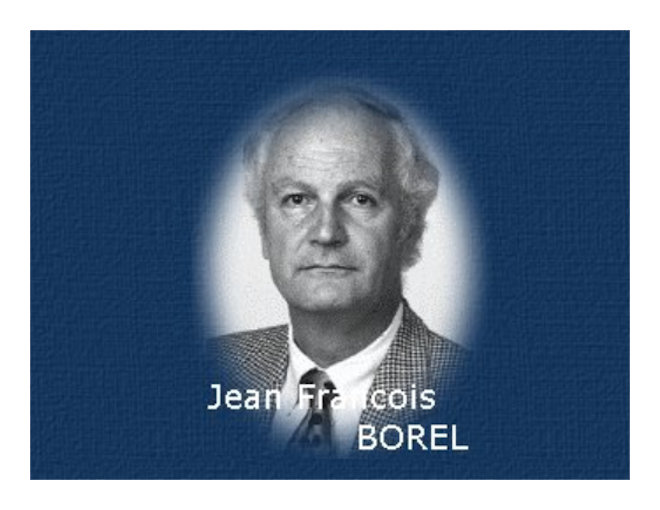Jean-François BOREL
Célébrités en cardiologie
(Celebrities in cardiology)

Jean-François Borel. © Heart and Coeur ©
 Jean Francois BOREL
Jean Francois BOREL
Découverte de la cyclosporine A
En 1972, le Dr Jean-François Borel (né en 1933 )des laboratoires Sandoz à Bâle (Suisse) mis en évidence des propriétés immunosuppressives de la ciclosporine.
Cette substance est extraite d’un champignon recueilli sur l’Hardangervidda, un haut-plateau du sud de la Norvège.
Les premiers essais sur des hommes ont eu lieu en 1978, et l’usage de la ciclosporine pour les greffes de moelle osseuse et les transplantations d’organes s’est généralisé en 1983.
Tout a commencé à Bâle, en 1969, dans le laboratoire de microbiologie de la firme Sandoz .
une poignée de terre ramassée au hasard d’un voyage en Norvège est à l’origine d’une longue histoire, celle de la
découverte de la ciclosporine...
Il s'appelle Ciclosporine A (Sandimmun): cet immunosuppresseur a été
découvert en 1972 par l'immunologiste suisse Jean-François Borel.
L'époque est à la recherche de nouveaux antibiotiques, et c'est par hasard, dans ce prélèvement de terre ramené de Norvège, que ce chercheur des Laboratoires Sandoz remarque un champignon semblant pourvu de capacités immunosuppressives.
Les tests ayant démontré que cette molécule paralyse les réactions immunitaires de l'organisme sans en détruire les cellules, la Ciclosporine est disponible au début des années 80.
 Jean Francois BOREL
Jean Francois BOREL
Discovery of cyclosporine A
Discovery of cyclosporinin 1971 began a new era in immunopharmacology.
It was the first immunosuppressive drug that allowed selective immunoregulation of T cells without excessive toxicity.
Cyclosporin was isolated from the fungus Tolypocladium inflatum.
Cyclosporin was first investigated as an anti-fungal antibiotic but its spectrum was too narrow to be of any clinical use. J. F. Borel discovered its immunosuppressive activity in 1976.
This led to further investigations into its properties involving further immunological tests and investigations into its structure and synthesis. Cyclosporin has unwanted side effects, notably nephrotoxicity.
Animal testing showed cyclosporin to be sufficiently non-toxic to begin clinical trials. These initially failed due to poor absorption of the drug. Once this had been overcome, results were encouraging enough for cyclosporin to be licensed for use in clinical practice.
There is some controversy between Borel and other workers over priority in the discovery of cyclosporin and its pre-clinical development, which is examined in this review. Cyclosporin changed the face of transplantation. It decreased morbidity and enabled the routine transplantation of organs that until then had only been done experimentally
It was in the immunology department led by Borel that the immunosuppressive activity of cyclosporin was discovered. However Stähelin [8] refutes the commonly held view that Borel discovered its activity.
Stähelin was in charge of the Pharmacology Department, of which the Immunology Group was a part. ‘The test [immunising mice with sheep erythrocytes] was performed in my [Stähelin’s] laboratory…. except for the titration which was done in Borel’s laboratory……Borel, not being interested in The General Screening Programme, did not see the results until later’.
Borel is also given much of the credit for the further development and promotion of cyclosporin, claiming he pursued its development throughout. Stähelin claims that Borel wanted to drop the development of cyclosporin after the failure to find immunosuppressant activity in dogs dosed with cyclosporin.
It is generally accepted that ‘Borel later was to risk his life…By experimenting on himself before cyclosporin toxicity was known…' [23]. This is in reference to the absorption experiment in which Borel and others participated. Stähelin claims that ‘this was an experiment arranged by B. von Gaffenried.. …The procedure was, of course, a controlled clinical trial, and not a self-administration.’
Inevitably, jealousy can arise when the credit for significant discoveries is attributed to one man. The contribution from others was equally vital in cyclosporin development. With so much mundane and routine work being carried out at Sandoz ( 1,000 preparations were fed into The General Screening programme e ach year), it is inevitable that there would be some controversy over the exact details of cyclosporin discovery and development.
Perhaps most credit should go to the scientists K. Saameli, who set up The General screening Programme and S. Lazary, who developed the testing for immunology before Borel had even arrived at Sandoz. The programme ensured that the immunosuppressive properties of any compound entered into it would be found. Luck, however, also played a part. If A. Rüeggerhad not entered the sample in the programme cyclosporin may have only ever been known as a weak antifungal agent, with no clinical value. However the combination of hard work and good luck bore fruit.



